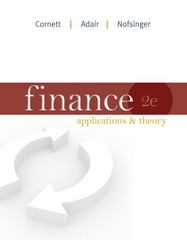



The following information is for the next four questions. An investor is presented with the following two alternative strategies: (1) Purchase a 5-year bond with an interest rate of 3.85% and hold it until maturity, or (2) purchase a 1-year bond with an interest rate of 4.00% and when it matures, purchase another 1-year bond with an expected rate of 1.75% and when that matures, purchase another 1-year bond with an interest rate of 6.50%. The investor can purchase a fourth 1-year bond with an interest rate of 1.75%. Finally, the investor can buy a fifth (and final) 1-year bond with an interest rate of 2.0%. What is the expected annual return over 5 years for the first strategy? What is the expected annual return over five years for the second strategy? True or False: Therefore, you would prefer the second strategy. True False Holding all else equal (i.e. investment strategy 1, as well as the rates on the first four bonds in strategy 2), what rate would you need to earn in the fifth year of the investment strategy 2 to be perfectly indifferent between the two strategies under the expectations process? The following information is for the next four questions. An investor is presented with the following two alternative strategies: (1) Purchase a 5-year bond with an interest rate of 3.85% and hold it until maturity, or (2) purchase a 1-year bond with an interest rate of 4.00% and when it matures, purchase another 1-year bond with an expected rate of 1.75% and when that matures, purchase another 1-year bond with an interest rate of 6.50%. The investor can purchase a fourth 1-year bond with an interest rate of 1.75%. Finally, the investor can buy a fifth (and final) 1-year bond with an interest rate of 2.0%. What is the expected annual return over 5 years for the first strategy? What is the expected annual return over five years for the second strategy? True or False: Therefore, you would prefer the second strategy. True False Holding all else equal (i.e. investment strategy 1, as well as the rates on the first four bonds in strategy 2), what rate would you need to earn in the fifth year of the investment strategy 2 to be perfectly indifferent between the two strategies under the expectations process










